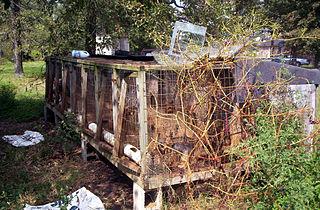
A kitten is a juvenile cat. After being born, kittens display primary altriciality and are fully dependent on their mothers for survival. They normally do not open their eyes for seven to ten days. After about two weeks, kittens develop quickly and begin to explore the world outside their nest. After a further three to four weeks, they begin to eat solid food and grow baby teeth. Domestic kittens are highly social animals and usually enjoy human companionship.

A puppy mill, also known as a puppy farm, is a commercial dog breeding facility characterized by quick breeding and poor conditions. Although no standardized legal definition for "puppy mill" exists, a definition was established in Avenson v. Zegart in 1984 as "a dog breeding operation in which the health of the mill’s dogs is disregarded to maintain a low overhead and maximize profits". They are cited as being a result of increased demand for household pets, especially after World War II. The Veterinary Medical Association of the Humane Society of the United States defines the main characteristics of a puppy mill as "emphasis on quantity over quality, indiscriminate breeding, continuous confinement, lack of human contact and environmental enrichment, poor husbandry, and minimal to no veterinary care."

Toilet training is the process of training someone, particularly a toddler or infant, to use the toilet for urination and defecation. Attitudes toward training in recent history have fluctuated substantially, and may vary across cultures and according to demographics. Many of the contemporary approaches to toilet training favor a behaviouralism- and cognitive psychology-based approach.

A leash is a rope or similar material used to control an animal by attaching it to a collar, harness, or halter. In British English, a leash is generally for a larger animal, with lead being more commonly used when walking a dog.

A litter box, also known as a sandbox, cat box, litter tray, cat pan, potty, pot or litter pan, is an indoor feces and urine collection box for cats, as well as rabbits, ferrets, miniature pigs, small dogs, and other pets that instinctively or through training will make use of such a repository. They are provided for pets that are permitted free roam of a home but who cannot or do not always go outside to excrete their metabolic waste.

Crate training is the process of training a pet to tolerate confinement in a dog crate or cage. Crate advocates often claim that dogs are "den-dwelling" animals and that a crate can become a "den" substitute and a familiar and safe location for the pet. Most puppies can eventually tolerate crate training if it is introduced properly. The initial stress from being confined can give way to "increased feelings of security, safety, and comfort" after repeated exposure to the crate. Long-term or excessive crate confinement "may lead to emotional and behavioral deterioration over time." On the other hand, if properly done, crate training can play a major role in housebreaking a dog as fast as possible. Confining a dog in a crate or cage restricts its movement and freedom, If crate training is not taken seriously, the dog may start soiling around the house.

A pet shop or pet store is an essential services retailer which sells animals and pet care resources to the public. A variety of animal supplies and pet accessories are also sold in pet shops. The products sold include: food, treats, toys, collars, leashes, cat litter, cages and aquariums.
Littlest Pet Shop is a toy franchise and cartoon series owned by Hasbro and currently under license with Basic Fun!. The original toy series was produced by Kenner in the early 1990s. An animated television series was made in 1995 by Sunbow Productions and Jean Chalopin Creativite et Developpement, based on the franchise.

A dog crate, dog cage, or kennel is a metal, wire, plastic, or fabric enclosure with a door in which a dog may be kept for security or transportation. Dog crates are designed to replicate a dog's natural den and as such can provide them with a place of refuge at home or when traveling to new surroundings. Other common reasons for using a dog crate are for toilet training a new puppy, transporting a dog, limiting access while the dog learns rules, ensuring the dog's safety, confining a dog in locations where dogs cannot safely or legally roam freely, or giving a dog a place to go when visitors come to the house.

Cats communicate for a variety of reasons, including to show happiness, express anger, solicit attention, and observe potential prey. Additionally, they collaborate, play, and share resources. When cats communicate with humans, they do so to get what they need or want, such as food, water, attention, or play. As such, cat communication methods have been significantly altered by domestication. Studies have shown that domestic cats tend to meow much more than feral cats. They rarely meow to communicate with fellow cats or other animals. Cats can socialize with each other and are known to form "social ladders," where a dominant cat is leading a few lesser cats. This is common in multi-cat households.

Cat behavior encompasses the actions and reactions displayed by a cat in response to various stimuli and events. Cat behavior includes body language, elimination habits, aggression, play, communication, hunting, grooming, urine marking, and face rubbing. It varies among individuals, colonies, and breeds.

Guiding Eyes for the Blind is a non-profit school based in Yorktown Heights, New York that trains guide dogs to aid people who are visually impaired. It also operates a canine development center in Patterson, New York, and a training site in White Plains, New York. It was the first guide dog training school to be accredited by the National Accreditation Council for Agencies Serving the Blind and Visually Handicapped.
The Blue Peter pets are animals that regularly appear on the long-running BBC children's television series Blue Peter. For 27 years, when not on TV, these pets were often looked after by Blue Peter's long-standing pet keeper Edith Menezes, who died in 1994. The exceptions were the dogs Petra, Shep and Goldie, who lived with Peter Purves, John Noakes and Simon Groom, respectively, for which the three presenters were paid a stipend for their upkeep.
Ian Dunbar is a veterinarian, animal behaviorist, and dog trainer. He received his veterinary degree and a Special Honours degree in Physiology & Biochemistry from the Royal Veterinary College, and a doctorate in animal behavior from the Psychology Department at UC Berkeley, where he researched the development of social hierarchies and aggression in domestic dogs.

Cat training is the process of modifying a domestic cat's behavior for entertainment or companionship purposes. Training is commonly used to reduce unwanted or problematic behaviors in domestic cats, to enhance interactions between humans and pet cats, and to allow them to coexist comfortably. There are various methods for training cats which employ different balances between reward and punishment.

Pet carriers are small portable boxes, crates, or cages used to transport small animals such as cats, lap dogs, miniature pigs, ferrets, chickens, guinea pigs, and so on, from one location to another.
Dog noise phobia, along with dog noise anxiety, are terms sometimes used by dog owners and veterinarians to describe canine fear of, and the corresponding stress responses to, loud noises.

Separation anxiety in dogs describes a condition in which a dog exhibits distress and behavior problems when separated from its handler. Separation anxiety typically manifests within minutes of departure of the handler. It is not fully understood why some dogs suffer from separation anxiety and others do not. The diagnosis process often leads to a misdiagnosis as it is difficult to differentiate from other medical and behavioral problems. The behavior may be secondary to an underlying medical condition. With chronic stress, impairments to physiological health can manifest. Increased stress in the dog alters hormone levels, thus decreasing natural immunity to various health problems.
Sarah Wilson is an American author, dog trainer, and international speaker. She is the author of eight books about subjects related to pet ownership.

Dog-like cat is a term in popular culture that refers to specific breeds of domestic cats that have unusual behavioral tendencies that are reminiscent of young domestic dogs. These are within the scope of feline behavior, and may be enhanced through selective breeding. These behaviors, not specific to any breed, include following people around from room to room, the desire to receive frequent moments of physical affection such as being held and petted, a lack of aggression toward some fellow animals, and a placid nature. Certain owners may successfully attempt to train their cats to perform on command, such as via clicker training, akin to canines and other domesticated animals.















